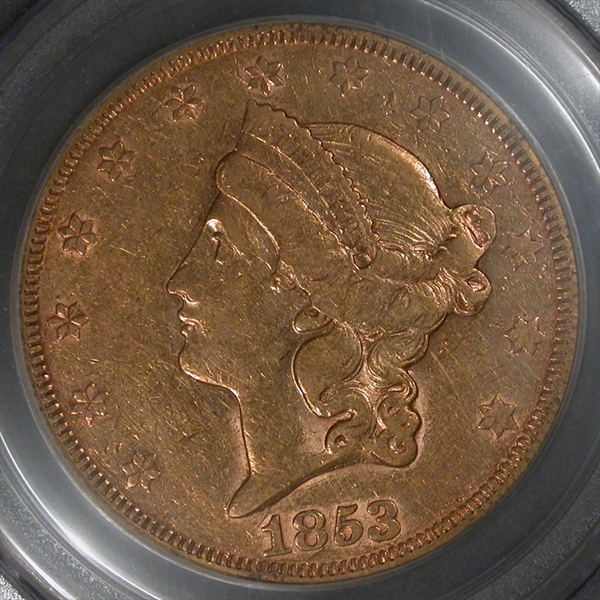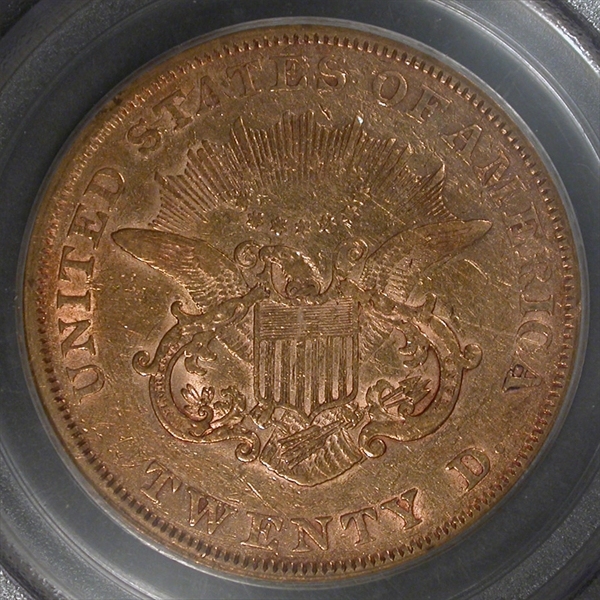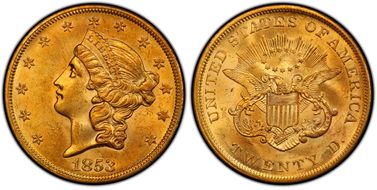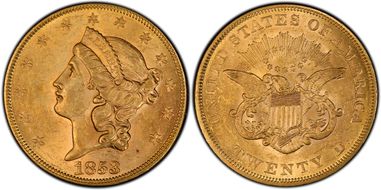1853/'2' $20 XF45 认证号06634241, PCGS号8909
拥有者评论
CAC. FS-G20-1853-301(G-008) - not listed on holder, Br.7162. Broken left side of crossbar in A(TES). Rust spot under R(TY). Rp'd above base of 1. Die lines from denticles at 2nd and last stars.
专家评论
Doug Winter
The following information is from my eBook on Type One Liberty Head Double Eagles at http://doubleeaglebook.com/The 1853/2 is the only recognized overdate in the entire Liberty Head double eagle series. It was not discovered until the 1950’s and didn’t begin to receive real publicity until the 1980’s. It is a controversial variety and there are camps who believe it is a true overdate and others who do not. I personally am somewhat ambivalent and can see the merits of both arguments.
STRIKE: This variety always shows weakness on the curls around the face of Liberty and below the ear. There is also weakness on the hair at the top of the head of Liberty and on the bun at the back of the hair. The stars are relatively well defined with many showing full radial lines and the obverse denticles are clearly separated. The reverse is always sharper than the obverse with all of the details clear except for the tips of the feathers and the left side of the scroll (the viewer’s right).
SURFACES: Nearly all known examples show abrasions which range from moderate to excessive. Many have been cleaned or processed as well. All genuine 1853/’2' double eagles show a small raised die dot below the R in LIBERTY and the left side of the crossbar of the A in STATES is broke. Another way to tell that a coin being offered as an overdate is the “real deal” is to look for repunching at the base of the 1 in the date. The variety which is accepted as the overdate has this repunching while the 1853 Repunched Date (described above) does not. Also, the 1853/’2' overdate shows two lines from the 2 between the lower knob and the inner right curve of the 3; the Repunched Date does not.
LUSTER: Many 1853/’2' double eagles have such extensive bagmarks that their luster is impaired. The relatively few choice pieces which I have seen or owned show a frosty texture. Any example with unimpaired luster is rare and desirable.
COLORATION: The natural coloration is a medium to deep orange-gold. Some are seen with a more green-gold shade. Very few 1853/’2' double eagles are known with original color.
EYE APPEAL: The eye appeal for this variety is well below average and this is among the hardest Type One double eagles to locate with above-average eye appeal. A CAC quality example is worth a significant premium over a typical quality piece.
PROOFS: No Proofs were struck this year.
HOARDS: Three were included in the S.S. Central America treasure including two in relatively high grades.
BUYING TIPS: Make certain that any coin you are considering purchasing conforms to the diagnostics above. This is probably not an issue that the advanced collector wants to “overbuy.” There is a growing sentiment that this is not a true overdate and if it gets “de-listed” by PCGS or NGC, prices could drop appreciably.
AUCTION RECORD: The current auction record for this variety is $48,875, set by a PCGS MS61 coin offered as Heritage 2005 ANA: 10395; it was earlier in the S.S. Central America treasure.
Other significant prices realized include the following:
Stacks Bowers 2012 ANA: 11752, graded MS61 by PCGS. The coin brought $46,000.
Heritage 3/06: 2001, graded MS61 by PCGS. The coin brought $41,688.
Heritage 1/04: 3083, graded MS61 by NGC. The coin brought $41,400.
Bass IV (Bowers and Merena 11/02): 802, graded MS61 by PCGS. The coin brought $41,400.
FINEST KNOWN: The highest-graded coin for this variety is a single NGC MS62 (ex: Heritage 2004 FUN: 3082 at $41,400), but I don’t regard this coin as being any nicer than the three or four different PCGS MS61 examples which I have seen. The specific example which stands out as being slightly better is the CAC-approved PCGS MS61 last sold as Bowers and Merena 2012 ANA: 11752 ($46,000).
RARITY:
TOTAL KNOWN: 200-300+
BY GRADE:
Very Fine: 50-80
Extremely Fine: 80-120
About Uncirculated: 65-93
Uncirculated: 5-7
POPULATION FIGURES: As of the beginning of 2015, PCGS had graded one in MS60 and six in MS61 for a total of seven. NGC had graded three in MS61 and one in MS62 as well as a single coin in MS61 from the S.S. Republic for a combined total of five in Uncirculated. These numbers may be very slightly inflated by resubmissions. CAC has approved just two Uncirculated coins, an MS60 and an MS61.
PERFORMANCE SINCE 2002: At the current time, a choice Extremely Fine example (equivalent to EF45) is worth $3,500-4,500. In 2002, the same coin in this grade was worth $2,000-3,000. In today’s market, a choice About Uncirculated 1853/’2' (equivalent to an AU55) is worth $10,000-12,000. In 2002, the same coin was worth $4,000-6,000. This variety has not performed as well as other Type One issues due to doubt about its status as a true overdate.
COMMENTS: There is still quite a bit of controversy regarding the true status of this variety. I believe it is and continue to list it in this book as such, but I can see the doubters’ argument as well. On page 75 of his book on Double Eagles, Dave Bowers states the following: “One variety of 1853 has been described as an overdate, but the writer considers it not to be as such and not even a close call.”
This is the only overdate in the $20 Liberty series and is quite scarce. Breen claimed to discover it in 1959 and wrote about it in his Complete Encyclopedia of United States Coins. All of those known share the same die characteristics. PCGS has graded only four coins in MS61 with none finer. When I handled an MS61 in 2006 there seemed to be some question as to whether there really were four different mint state examples or if that number was inflated.
PCGS #
8909
设计师
James Barton Longacre
边缘
Reeded
直径
34.00 毫米
重量
33.40 克
铸币数量
1261326
金属成分
90% Gold, 10% Copper
更高评级数量
116
评级较低的钱币数量
15
地区
The United States of America
价格指南
PCGS 数量报告
拍卖 - PCGS 评级的
拍卖 - NGC 评级的
























